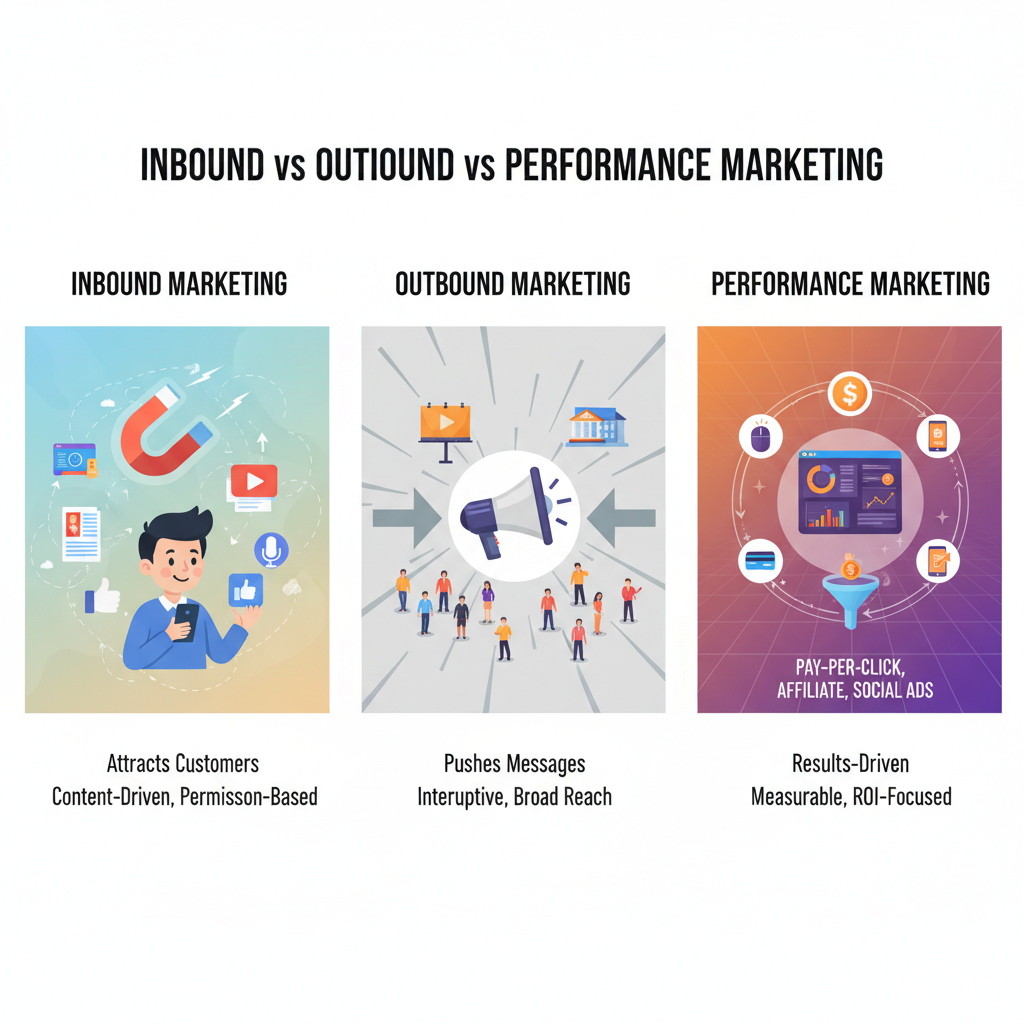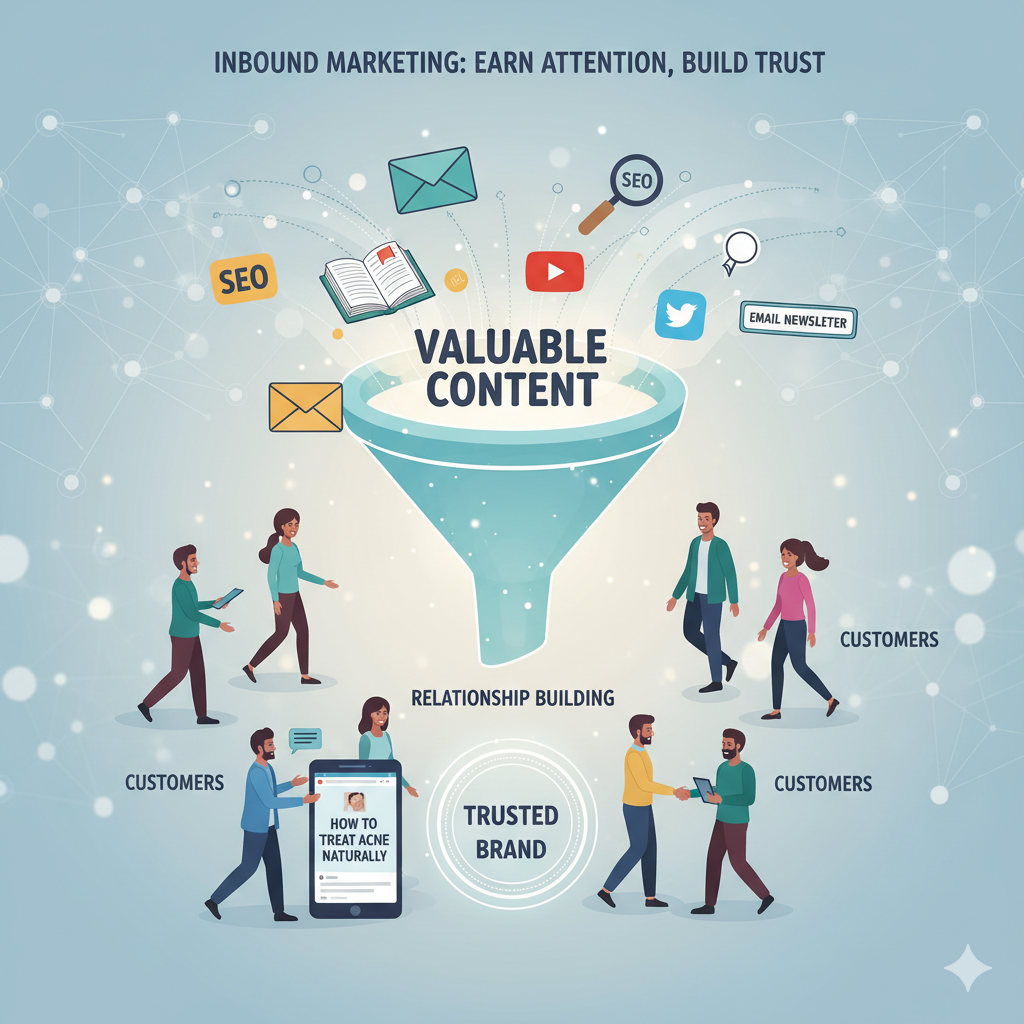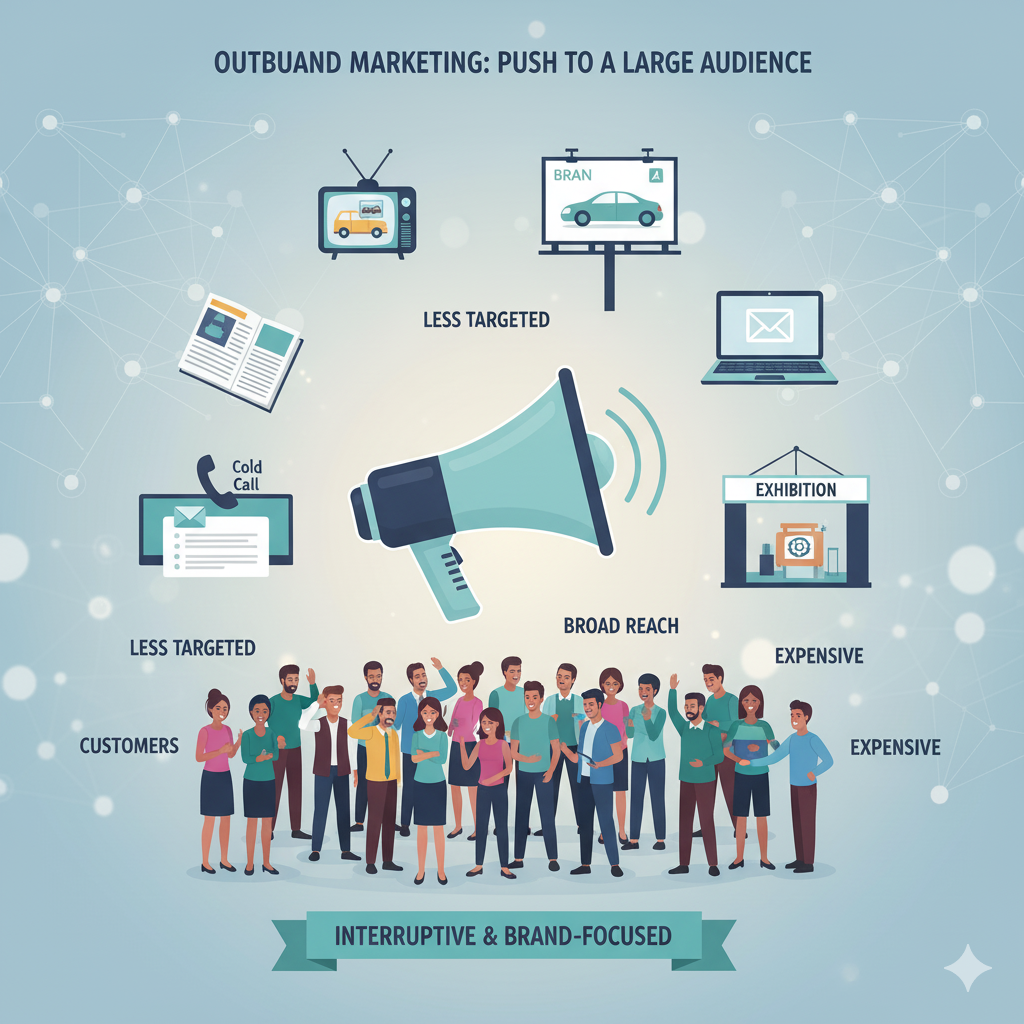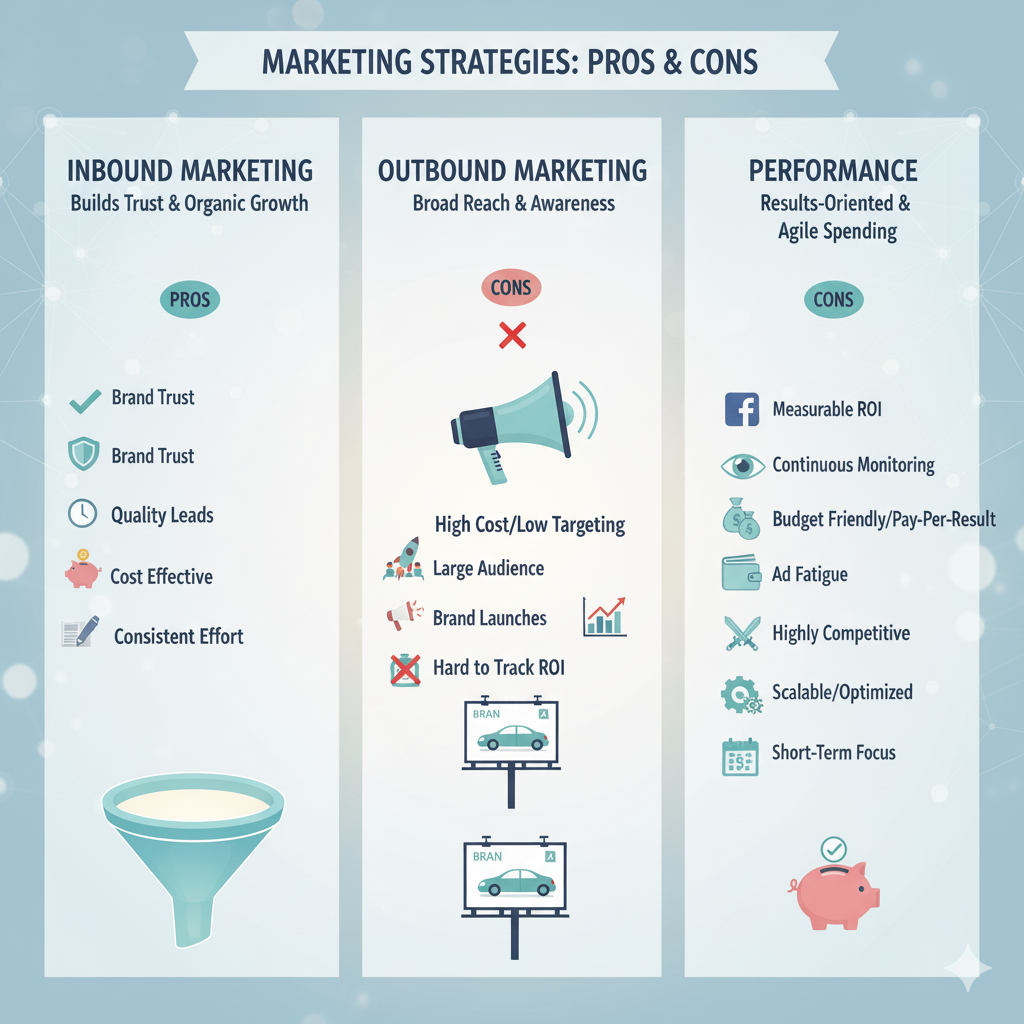Introduction

In the fast changing world of marketing, businesses have access to multiple ways to reach and engage with potential customers. However, the challenge lies in choosing the right approach that aligns with their goals, audience, and budget.
Three of the most commonly discussed and often misunderstood marketing strategies are Inbound Marketing, Outbound Marketing, and Performance Marketing. Although all three aim to attract customers and generate sales, they differ greatly in their approach, communication style, and how success is measured.
This blog explores each strategy in detail, provides real world examples, and highlights the differences to help you decide which method is best suited for your business.
What is Inbound Marketing

Inbound marketing is a pull strategy where businesses attract customers through valuable and relevant content instead of directly promoting products. The idea is to provide helpful information that naturally draws people to your brand.
Inbound marketing focuses on building trust, solving problems, and creating lasting relationships with customers. It emphasizes earning attention rather than buying it.
Common Inbound Marketing Methods
- Content Marketing: Writing blog posts, articles, and guides that educate or inform your audience.
- Search Engine Optimization (SEO): Optimizing your content so that people find your website when they search for related topics.
- Social Media Marketing: Sharing useful, engaging, and entertaining content that attracts followers.
- Email Marketing: Sending newsletters that provide helpful updates and personalized offers to your subscribers.
Real World Example
Imagine a skincare brand that publishes blogs on topics such as How to Treat Acne Naturally or Best Ingredients for Sensitive Skin. The brand also shares skincare tips on Instagram and YouTube. These efforts attract customers who are genuinely interested in skincare solutions.
Instead of pushing ads, the brand earns trust and builds relationships. When those readers are ready to buy, they are more likely to choose this brand.
Inbound marketing is all about being found by the right audience through valuable and trustworthy content.
What is Outbound Marketing

Outbound marketing is a push strategy where companies actively send their message to a large audience, whether or not they are interested in the product. It is the traditional form of marketing that focuses on spreading awareness and grabbing attention quickly.
This approach can be powerful for brand visibility but is often less targeted and more expensive compared to inbound marketing.
Common Outbound Marketing Methods
- Television and Radio Advertising
- Newspaper and Magazine Ads
- Billboards and Hoardings
- Cold Calling and Email Campaigns
- Trade Shows, Exhibitions, and Sponsorships
Real World Example
A car manufacturer launching a new vehicle might run advertisements on TV, newspapers, and billboards across the country. The goal is to reach as many people as possible and build brand awareness, even if not everyone is planning to buy a car.
Outbound marketing helps create recognition and trust by ensuring the brand stays in the audience’s memory.
What is Performance Marketing

Performance marketing is a result oriented digital marketing approach where advertisers pay only when a specific action occurs. These actions could be a click, a form submission, a lead, or an actual sale.
It focuses on measurable outcomes, allowing businesses to track return on investment with great accuracy. It combines data analytics, targeting, and optimization to get the best possible results for each campaign.
Common Performance Marketing Methods
- Pay Per Click Advertising such as Google Ads
- Social Media Advertising on platforms like Facebook, Instagram, or LinkedIn
- Affiliate Marketing where partners earn commissions for generating sales
- Influencer Marketing based on measurable engagement or conversions
Real World Example
Consider an online clothing store that runs a Facebook ad campaign promoting a seasonal discount. The store pays only when users click the ad or complete a purchase. The campaign results can be measured in real time through metrics such as cost per click, cost per acquisition, and conversion rate.
This allows the business to adjust the campaign instantly and spend only where results are visible. That is the core of performance marketing.
Major Differences Between Inbound Outbound and Performance Marketing
| Aspect | Inbound Marketing | Outbound Marketing | Performance Marketing |
|---|---|---|---|
| Approach | Pull strategy attracting customers naturally | Push strategy reaching out to a wide audience | Data driven strategy focused on measurable actions |
| Goal | Build trust authority and long term relationships | Create awareness and brand visibility | Achieve specific results such as leads or sales |
| Mediums Used | Blogs SEO social media content | TV radio print billboards cold calls | Google Ads Meta Ads affiliates influencers |
| Audience Targeting | Highly targeted and intent based | Broad and general | Hyper targeted using data and analytics |
| Measurement | Based on engagement and organic growth | Difficult to measure accurately | Easily measurable through metrics and dashboards |
| Cost Structure | Long term investment lower cost over time | High upfront cost | Pay only for performance based actions |
| Best Suited For | Building credibility and long term growth | Increasing awareness and recall | Driving measurable short term results |
Pros and Cons of Each Marketing Approach

Inbound Marketing
Advantages
- Builds brand trust and credibility
- Generates quality leads organically
- Cost effective in the long run
Disadvantages
- Takes time to produce results
- Requires consistent content creation and strategy
Outbound Marketing
Advantages
- Reaches large audiences quickly
- Ideal for brand launches or awareness campaigns
Disadvantages
- High cost and lower targeting precision
- Difficult to track exact ROI
- Often ignored by audiences due to ad fatigue
Performance Marketing
Advantages
- Measurable results with clear ROI
- Budget friendly due to pay per result model
- Easily scalable and optimized in real time
Disadvantages
- Needs continuous monitoring and optimization
- Can become highly competitive in digital spaces
- Focuses on short term outcomes more than brand building
Choosing the Right Strategy for Your Business
The best marketing strategy depends on your objectives, industry type, and target audience.
- Inbound Marketing is best for businesses that want to build trust and attract customers organically. It works well for service providers, educational institutions, and brands that rely on expertise and thought leadership.
- Outbound Marketing is suitable for companies that need mass exposure in a short time. It works well for new product launches, established brands, or industries like automobiles and consumer goods.
- Performance Marketing is ideal for e commerce businesses, startups, or digital first brands that need direct and measurable results quickly.
For example, a healthcare clinic can use inbound marketing through informative blogs about allergies, outbound marketing through newspaper ads, and performance marketing through Google Ads to drive appointment bookings.
Combining All Three for Maximum Impact
Modern marketing is most effective when these three strategies work together.
- Inbound Marketing builds awareness and trust through valuable content.
- Outbound Marketing creates brand recall among a larger audience.
- Performance Marketing converts that audience into measurable results.
For instance, a travel agency might publish blog articles about tourist destinations to attract readers inbound marketing run television ads to reach local families outbound marketing and use Meta Ads to promote special vacation packages performance marketing.
By blending all three, the business achieves both visibility and measurable growth.
Conclusion
Inbound Outbound and Performance Marketing each serve a unique purpose in helping businesses reach their goals.
- Inbound Marketing focuses on building long term relationships through trust and education.
- Outbound Marketing emphasizes brand visibility and broad audience reach.
- Performance Marketing ensures that every marketing rupee spent leads to trackable and measurable outcomes.
The most successful brands understand how to balance these three methods for maximum impact. By integrating content strategy traditional promotion and data driven advertising businesses can create a complete marketing system that builds awareness engagement and measurable success.